Business Communication Report: Analysis of Email Newsletters and Memos
VerifiedAdded on 2022/03/29
|11
|3279
|34
Report
AI Summary
This report provides a comprehensive analysis of business communication, encompassing various aspects such as email newsletters, memos, and effective communication strategies. It begins by exploring the aims of business communication, including information, persuasion, and motivation, and then delves into the communication process, highlighting barriers that may arise from both the sender and receiver, along with methods to overcome them. The report also examines different communication models, such as Shannon's and Berlo's models, to provide a foundational understanding of the communication process. Furthermore, it discusses communication mediums for various situations within an organization, differentiating between verbal, written, and nonverbal communication, and provides insights into effective face-to-face communication, including the role of body language and physical appearance. The report also differentiates between formal and informal communication, offering best practices for each to promote effective communication within an organization. Overall, this report offers a detailed overview of essential business communication concepts and practical strategies for enhancing communication effectiveness.
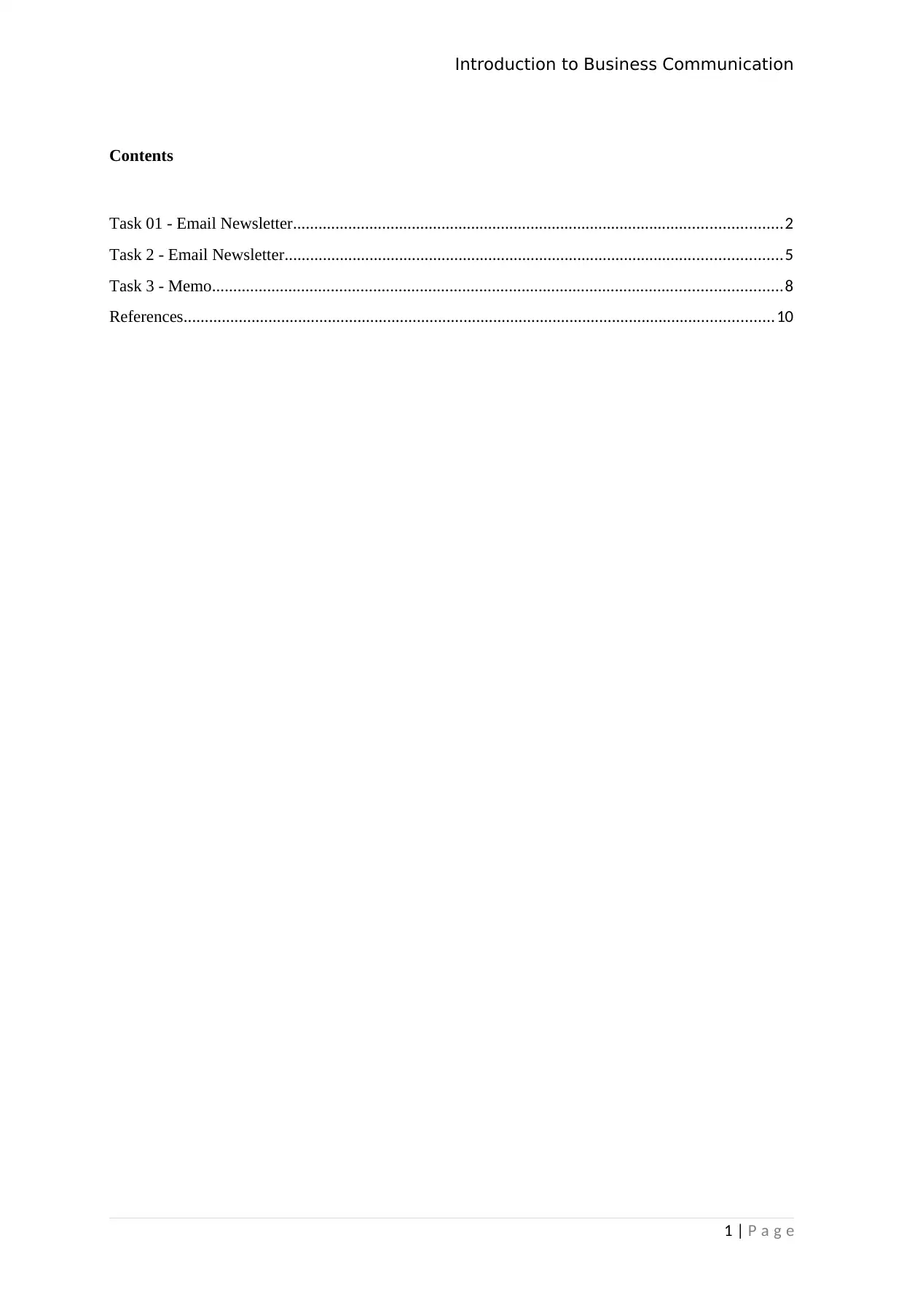
Introduction to Business Communication
Contents
Task 01 - Email Newsletter...................................................................................................................2
Task 2 - Email Newsletter.....................................................................................................................5
Task 3 - Memo......................................................................................................................................8
References...........................................................................................................................................10
1 | P a g e
Contents
Task 01 - Email Newsletter...................................................................................................................2
Task 2 - Email Newsletter.....................................................................................................................5
Task 3 - Memo......................................................................................................................................8
References...........................................................................................................................................10
1 | P a g e
Paraphrase This Document
Need a fresh take? Get an instant paraphrase of this document with our AI Paraphraser
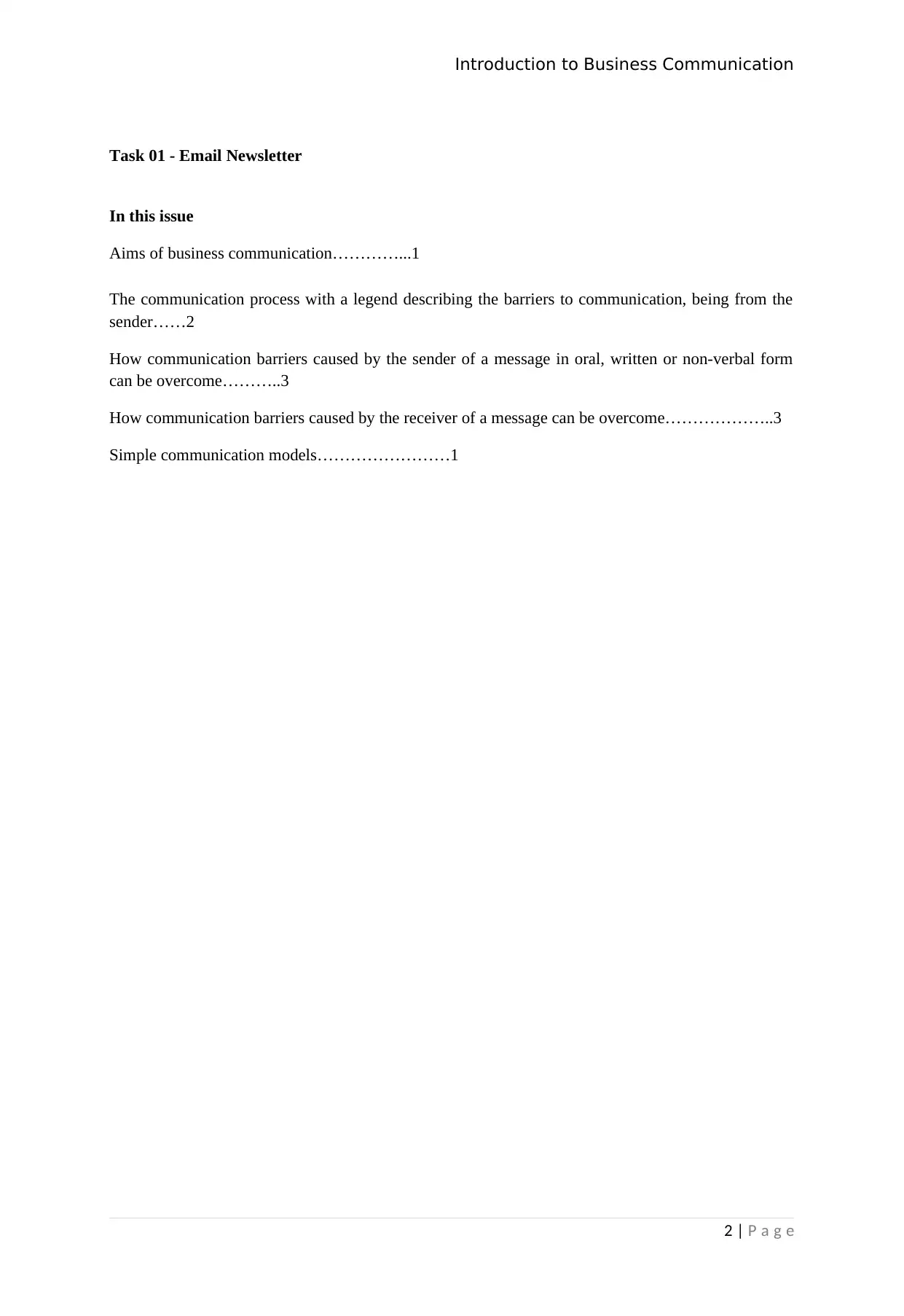
Introduction to Business Communication
Task 01 - Email Newsletter
In this issue
Aims of business communication…………...1
The communication process with a legend describing the barriers to communication, being from the
sender……2
How communication barriers caused by the sender of a message in oral, written or non-verbal form
can be overcome………..3
How communication barriers caused by the receiver of a message can be overcome………………..3
Simple communication models……………………1
2 | P a g e
Task 01 - Email Newsletter
In this issue
Aims of business communication…………...1
The communication process with a legend describing the barriers to communication, being from the
sender……2
How communication barriers caused by the sender of a message in oral, written or non-verbal form
can be overcome………..3
How communication barriers caused by the receiver of a message can be overcome………………..3
Simple communication models……………………1
2 | P a g e
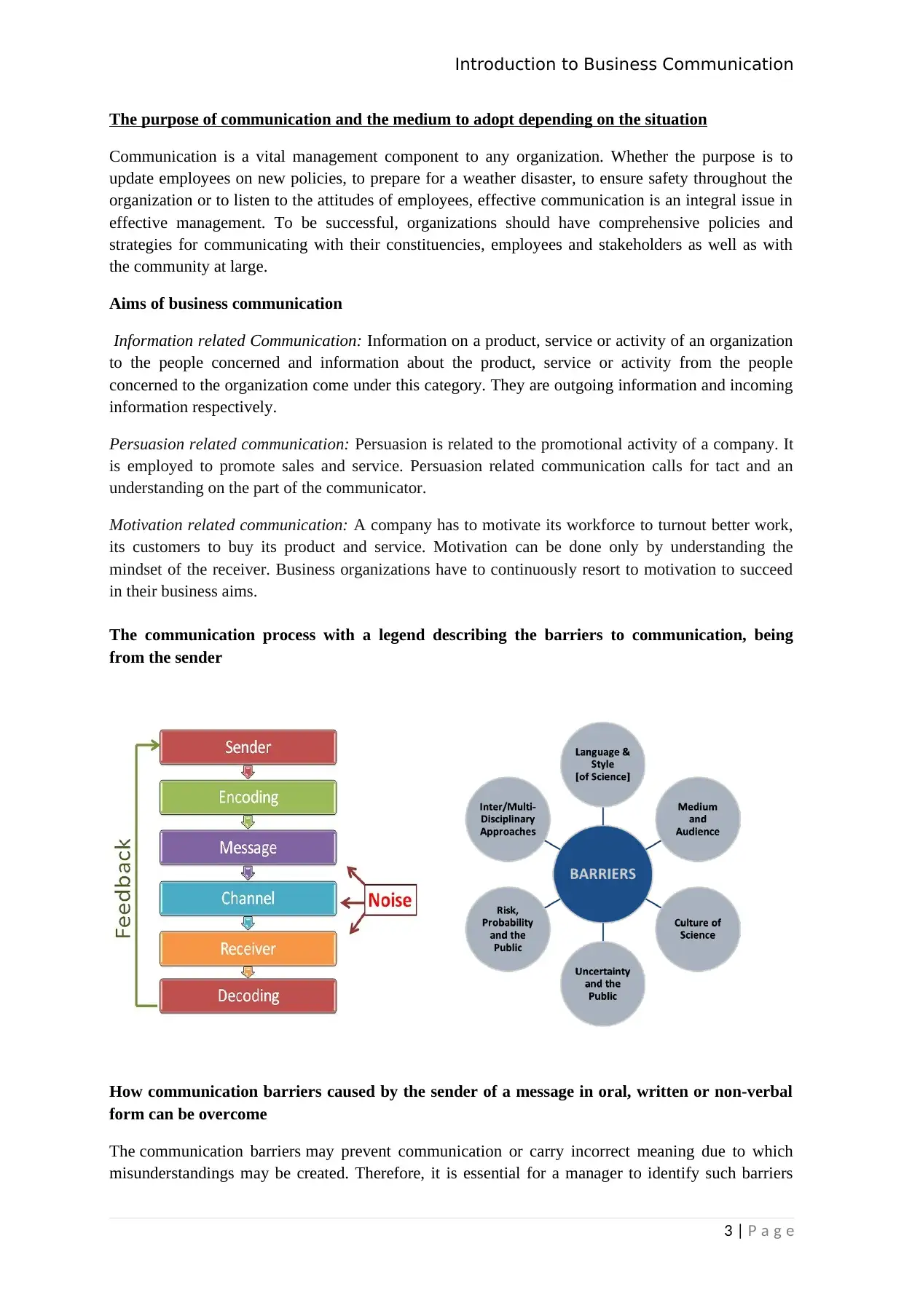
Introduction to Business Communication
The purpose of communication and the medium to adopt depending on the situation
Communication is a vital management component to any organization. Whether the purpose is to
update employees on new policies, to prepare for a weather disaster, to ensure safety throughout the
organization or to listen to the attitudes of employees, effective communication is an integral issue in
effective management. To be successful, organizations should have comprehensive policies and
strategies for communicating with their constituencies, employees and stakeholders as well as with
the community at large.
Aims of business communication
Information related Communication: Information on a product, service or activity of an organization
to the people concerned and information about the product, service or activity from the people
concerned to the organization come under this category. They are outgoing information and incoming
information respectively.
Persuasion related communication: Persuasion is related to the promotional activity of a company. It
is employed to promote sales and service. Persuasion related communication calls for tact and an
understanding on the part of the communicator.
Motivation related communication: A company has to motivate its workforce to turnout better work,
its customers to buy its product and service. Motivation can be done only by understanding the
mindset of the receiver. Business organizations have to continuously resort to motivation to succeed
in their business aims.
The communication process with a legend describing the barriers to communication, being
from the sender
How communication barriers caused by the sender of a message in oral, written or non-verbal
form can be overcome
The communication barriers may prevent communication or carry incorrect meaning due to which
misunderstandings may be created. Therefore, it is essential for a manager to identify such barriers
3 | P a g e
The purpose of communication and the medium to adopt depending on the situation
Communication is a vital management component to any organization. Whether the purpose is to
update employees on new policies, to prepare for a weather disaster, to ensure safety throughout the
organization or to listen to the attitudes of employees, effective communication is an integral issue in
effective management. To be successful, organizations should have comprehensive policies and
strategies for communicating with their constituencies, employees and stakeholders as well as with
the community at large.
Aims of business communication
Information related Communication: Information on a product, service or activity of an organization
to the people concerned and information about the product, service or activity from the people
concerned to the organization come under this category. They are outgoing information and incoming
information respectively.
Persuasion related communication: Persuasion is related to the promotional activity of a company. It
is employed to promote sales and service. Persuasion related communication calls for tact and an
understanding on the part of the communicator.
Motivation related communication: A company has to motivate its workforce to turnout better work,
its customers to buy its product and service. Motivation can be done only by understanding the
mindset of the receiver. Business organizations have to continuously resort to motivation to succeed
in their business aims.
The communication process with a legend describing the barriers to communication, being
from the sender
How communication barriers caused by the sender of a message in oral, written or non-verbal
form can be overcome
The communication barriers may prevent communication or carry incorrect meaning due to which
misunderstandings may be created. Therefore, it is essential for a manager to identify such barriers
3 | P a g e
⊘ This is a preview!⊘
Do you want full access?
Subscribe today to unlock all pages.

Trusted by 1+ million students worldwide
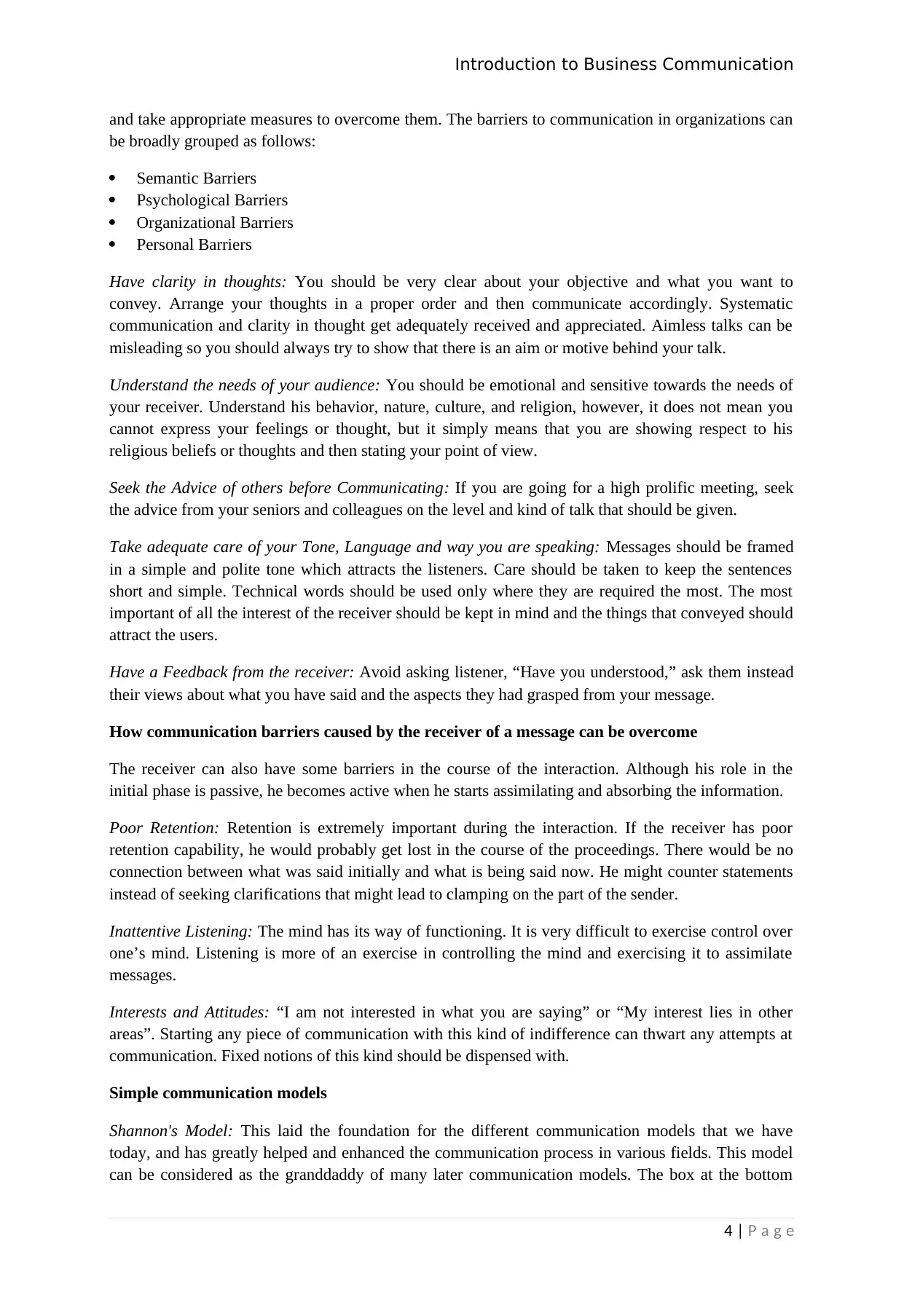
Introduction to Business Communication
and take appropriate measures to overcome them. The barriers to communication in organizations can
be broadly grouped as follows:
Semantic Barriers
Psychological Barriers
Organizational Barriers
Personal Barriers
Have clarity in thoughts: You should be very clear about your objective and what you want to
convey. Arrange your thoughts in a proper order and then communicate accordingly. Systematic
communication and clarity in thought get adequately received and appreciated. Aimless talks can be
misleading so you should always try to show that there is an aim or motive behind your talk.
Understand the needs of your audience: You should be emotional and sensitive towards the needs of
your receiver. Understand his behavior, nature, culture, and religion, however, it does not mean you
cannot express your feelings or thought, but it simply means that you are showing respect to his
religious beliefs or thoughts and then stating your point of view.
Seek the Advice of others before Communicating: If you are going for a high prolific meeting, seek
the advice from your seniors and colleagues on the level and kind of talk that should be given.
Take adequate care of your Tone, Language and way you are speaking: Messages should be framed
in a simple and polite tone which attracts the listeners. Care should be taken to keep the sentences
short and simple. Technical words should be used only where they are required the most. The most
important of all the interest of the receiver should be kept in mind and the things that conveyed should
attract the users.
Have a Feedback from the receiver: Avoid asking listener, “Have you understood,” ask them instead
their views about what you have said and the aspects they had grasped from your message.
How communication barriers caused by the receiver of a message can be overcome
The receiver can also have some barriers in the course of the interaction. Although his role in the
initial phase is passive, he becomes active when he starts assimilating and absorbing the information.
Poor Retention: Retention is extremely important during the interaction. If the receiver has poor
retention capability, he would probably get lost in the course of the proceedings. There would be no
connection between what was said initially and what is being said now. He might counter statements
instead of seeking clarifications that might lead to clamping on the part of the sender.
Inattentive Listening: The mind has its way of functioning. It is very difficult to exercise control over
one’s mind. Listening is more of an exercise in controlling the mind and exercising it to assimilate
messages.
Interests and Attitudes: “I am not interested in what you are saying” or “My interest lies in other
areas”. Starting any piece of communication with this kind of indifference can thwart any attempts at
communication. Fixed notions of this kind should be dispensed with.
Simple communication models
Shannon's Model: This laid the foundation for the different communication models that we have
today, and has greatly helped and enhanced the communication process in various fields. This model
can be considered as the granddaddy of many later communication models. The box at the bottom
4 | P a g e
and take appropriate measures to overcome them. The barriers to communication in organizations can
be broadly grouped as follows:
Semantic Barriers
Psychological Barriers
Organizational Barriers
Personal Barriers
Have clarity in thoughts: You should be very clear about your objective and what you want to
convey. Arrange your thoughts in a proper order and then communicate accordingly. Systematic
communication and clarity in thought get adequately received and appreciated. Aimless talks can be
misleading so you should always try to show that there is an aim or motive behind your talk.
Understand the needs of your audience: You should be emotional and sensitive towards the needs of
your receiver. Understand his behavior, nature, culture, and religion, however, it does not mean you
cannot express your feelings or thought, but it simply means that you are showing respect to his
religious beliefs or thoughts and then stating your point of view.
Seek the Advice of others before Communicating: If you are going for a high prolific meeting, seek
the advice from your seniors and colleagues on the level and kind of talk that should be given.
Take adequate care of your Tone, Language and way you are speaking: Messages should be framed
in a simple and polite tone which attracts the listeners. Care should be taken to keep the sentences
short and simple. Technical words should be used only where they are required the most. The most
important of all the interest of the receiver should be kept in mind and the things that conveyed should
attract the users.
Have a Feedback from the receiver: Avoid asking listener, “Have you understood,” ask them instead
their views about what you have said and the aspects they had grasped from your message.
How communication barriers caused by the receiver of a message can be overcome
The receiver can also have some barriers in the course of the interaction. Although his role in the
initial phase is passive, he becomes active when he starts assimilating and absorbing the information.
Poor Retention: Retention is extremely important during the interaction. If the receiver has poor
retention capability, he would probably get lost in the course of the proceedings. There would be no
connection between what was said initially and what is being said now. He might counter statements
instead of seeking clarifications that might lead to clamping on the part of the sender.
Inattentive Listening: The mind has its way of functioning. It is very difficult to exercise control over
one’s mind. Listening is more of an exercise in controlling the mind and exercising it to assimilate
messages.
Interests and Attitudes: “I am not interested in what you are saying” or “My interest lies in other
areas”. Starting any piece of communication with this kind of indifference can thwart any attempts at
communication. Fixed notions of this kind should be dispensed with.
Simple communication models
Shannon's Model: This laid the foundation for the different communication models that we have
today, and has greatly helped and enhanced the communication process in various fields. This model
can be considered as the granddaddy of many later communication models. The box at the bottom
4 | P a g e
Paraphrase This Document
Need a fresh take? Get an instant paraphrase of this document with our AI Paraphraser
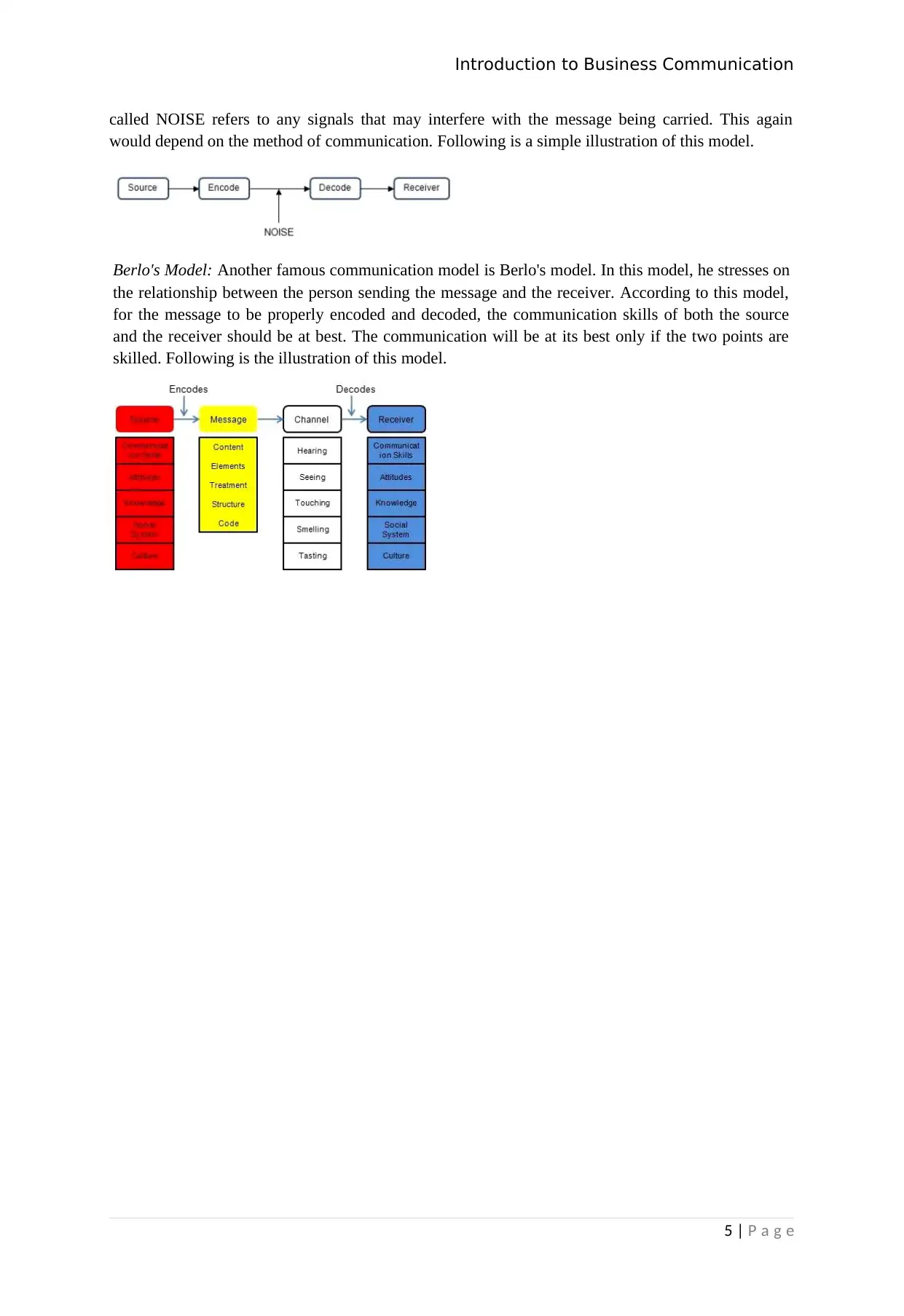
Introduction to Business Communication
called NOISE refers to any signals that may interfere with the message being carried. This again
would depend on the method of communication. Following is a simple illustration of this model.
Berlo's Model: Another famous communication model is Berlo's model. In this model, he stresses on
the relationship between the person sending the message and the receiver. According to this model,
for the message to be properly encoded and decoded, the communication skills of both the source
and the receiver should be at best. The communication will be at its best only if the two points are
skilled. Following is the illustration of this model.
5 | P a g e
called NOISE refers to any signals that may interfere with the message being carried. This again
would depend on the method of communication. Following is a simple illustration of this model.
Berlo's Model: Another famous communication model is Berlo's model. In this model, he stresses on
the relationship between the person sending the message and the receiver. According to this model,
for the message to be properly encoded and decoded, the communication skills of both the source
and the receiver should be at best. The communication will be at its best only if the two points are
skilled. Following is the illustration of this model.
5 | P a g e
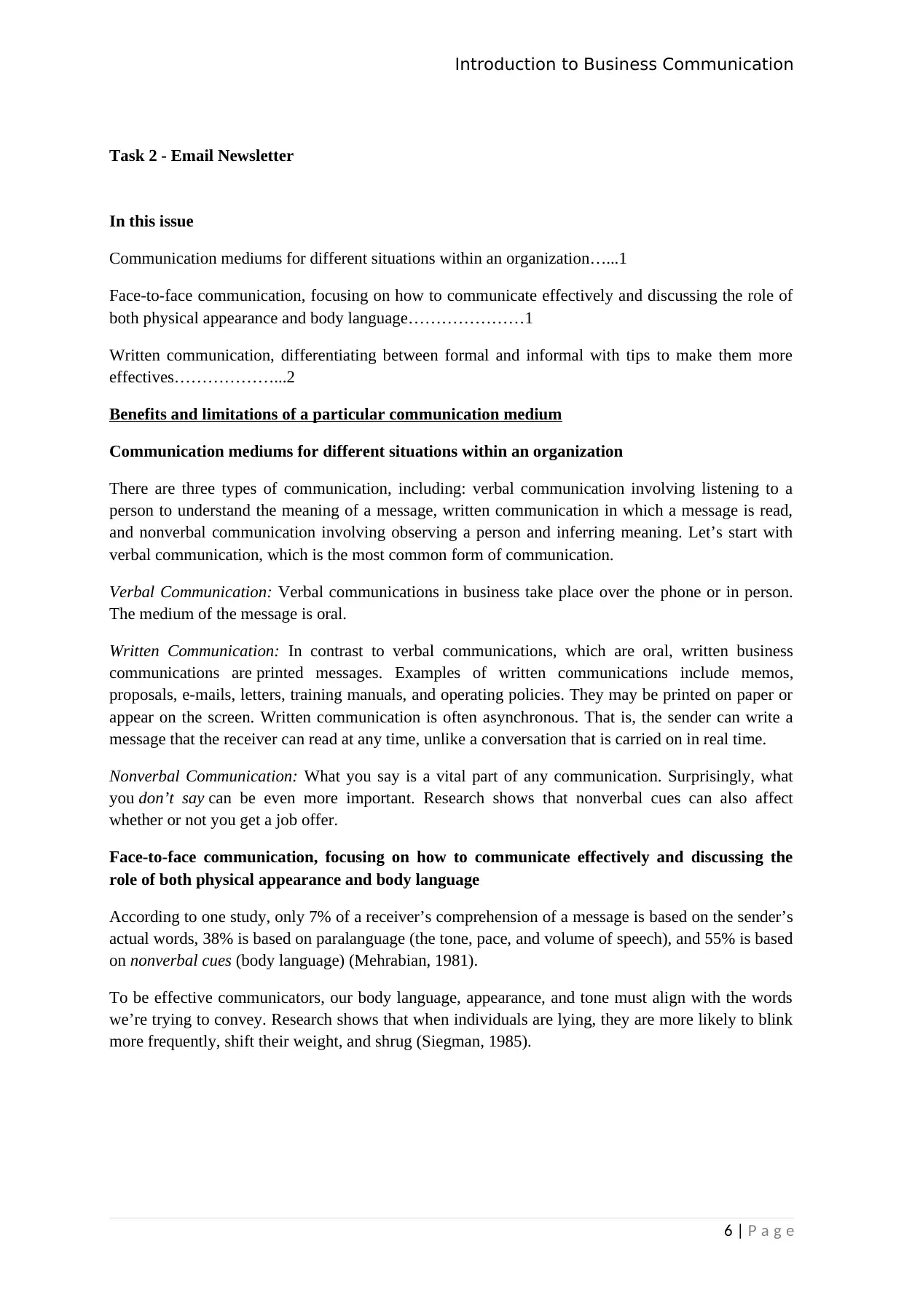
Introduction to Business Communication
Task 2 - Email Newsletter
In this issue
Communication mediums for different situations within an organization…...1
Face-to-face communication, focusing on how to communicate effectively and discussing the role of
both physical appearance and body language…………………1
Written communication, differentiating between formal and informal with tips to make them more
effectives………………...2
Benefits and limitations of a particular communication medium
Communication mediums for different situations within an organization
There are three types of communication, including: verbal communication involving listening to a
person to understand the meaning of a message, written communication in which a message is read,
and nonverbal communication involving observing a person and inferring meaning. Let’s start with
verbal communication, which is the most common form of communication.
Verbal Communication: Verbal communications in business take place over the phone or in person.
The medium of the message is oral.
Written Communication: In contrast to verbal communications, which are oral, written business
communications are printed messages. Examples of written communications include memos,
proposals, e-mails, letters, training manuals, and operating policies. They may be printed on paper or
appear on the screen. Written communication is often asynchronous. That is, the sender can write a
message that the receiver can read at any time, unlike a conversation that is carried on in real time.
Nonverbal Communication: What you say is a vital part of any communication. Surprisingly, what
you don’t say can be even more important. Research shows that nonverbal cues can also affect
whether or not you get a job offer.
Face-to-face communication, focusing on how to communicate effectively and discussing the
role of both physical appearance and body language
According to one study, only 7% of a receiver’s comprehension of a message is based on the sender’s
actual words, 38% is based on paralanguage (the tone, pace, and volume of speech), and 55% is based
on nonverbal cues (body language) (Mehrabian, 1981).
To be effective communicators, our body language, appearance, and tone must align with the words
we’re trying to convey. Research shows that when individuals are lying, they are more likely to blink
more frequently, shift their weight, and shrug (Siegman, 1985).
6 | P a g e
Task 2 - Email Newsletter
In this issue
Communication mediums for different situations within an organization…...1
Face-to-face communication, focusing on how to communicate effectively and discussing the role of
both physical appearance and body language…………………1
Written communication, differentiating between formal and informal with tips to make them more
effectives………………...2
Benefits and limitations of a particular communication medium
Communication mediums for different situations within an organization
There are three types of communication, including: verbal communication involving listening to a
person to understand the meaning of a message, written communication in which a message is read,
and nonverbal communication involving observing a person and inferring meaning. Let’s start with
verbal communication, which is the most common form of communication.
Verbal Communication: Verbal communications in business take place over the phone or in person.
The medium of the message is oral.
Written Communication: In contrast to verbal communications, which are oral, written business
communications are printed messages. Examples of written communications include memos,
proposals, e-mails, letters, training manuals, and operating policies. They may be printed on paper or
appear on the screen. Written communication is often asynchronous. That is, the sender can write a
message that the receiver can read at any time, unlike a conversation that is carried on in real time.
Nonverbal Communication: What you say is a vital part of any communication. Surprisingly, what
you don’t say can be even more important. Research shows that nonverbal cues can also affect
whether or not you get a job offer.
Face-to-face communication, focusing on how to communicate effectively and discussing the
role of both physical appearance and body language
According to one study, only 7% of a receiver’s comprehension of a message is based on the sender’s
actual words, 38% is based on paralanguage (the tone, pace, and volume of speech), and 55% is based
on nonverbal cues (body language) (Mehrabian, 1981).
To be effective communicators, our body language, appearance, and tone must align with the words
we’re trying to convey. Research shows that when individuals are lying, they are more likely to blink
more frequently, shift their weight, and shrug (Siegman, 1985).
6 | P a g e
⊘ This is a preview!⊘
Do you want full access?
Subscribe today to unlock all pages.

Trusted by 1+ million students worldwide
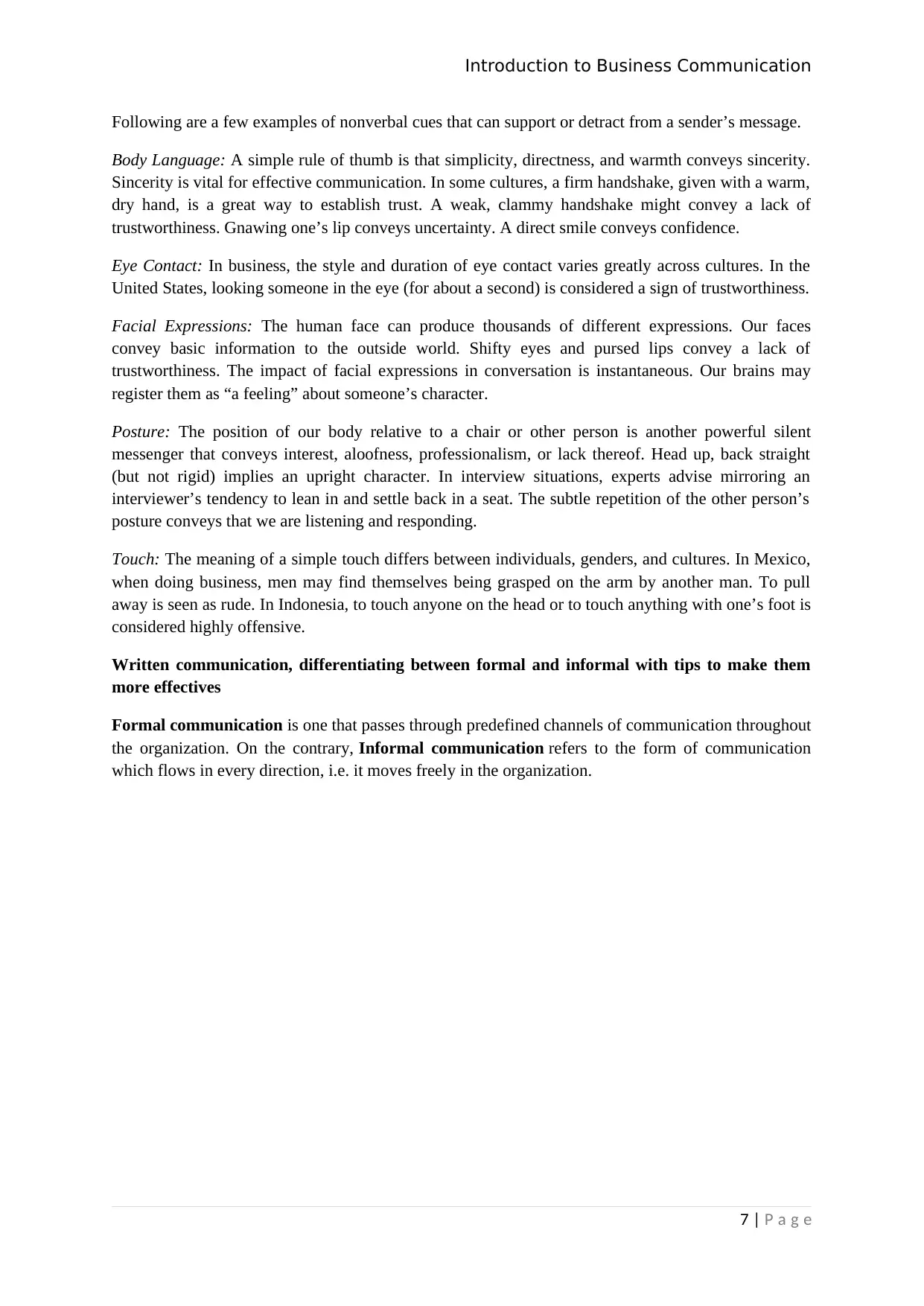
Introduction to Business Communication
Following are a few examples of nonverbal cues that can support or detract from a sender’s message.
Body Language: A simple rule of thumb is that simplicity, directness, and warmth conveys sincerity.
Sincerity is vital for effective communication. In some cultures, a firm handshake, given with a warm,
dry hand, is a great way to establish trust. A weak, clammy handshake might convey a lack of
trustworthiness. Gnawing one’s lip conveys uncertainty. A direct smile conveys confidence.
Eye Contact: In business, the style and duration of eye contact varies greatly across cultures. In the
United States, looking someone in the eye (for about a second) is considered a sign of trustworthiness.
Facial Expressions: The human face can produce thousands of different expressions. Our faces
convey basic information to the outside world. Shifty eyes and pursed lips convey a lack of
trustworthiness. The impact of facial expressions in conversation is instantaneous. Our brains may
register them as “a feeling” about someone’s character.
Posture: The position of our body relative to a chair or other person is another powerful silent
messenger that conveys interest, aloofness, professionalism, or lack thereof. Head up, back straight
(but not rigid) implies an upright character. In interview situations, experts advise mirroring an
interviewer’s tendency to lean in and settle back in a seat. The subtle repetition of the other person’s
posture conveys that we are listening and responding.
Touch: The meaning of a simple touch differs between individuals, genders, and cultures. In Mexico,
when doing business, men may find themselves being grasped on the arm by another man. To pull
away is seen as rude. In Indonesia, to touch anyone on the head or to touch anything with one’s foot is
considered highly offensive.
Written communication, differentiating between formal and informal with tips to make them
more effectives
Formal communication is one that passes through predefined channels of communication throughout
the organization. On the contrary, Informal communication refers to the form of communication
which flows in every direction, i.e. it moves freely in the organization.
7 | P a g e
Following are a few examples of nonverbal cues that can support or detract from a sender’s message.
Body Language: A simple rule of thumb is that simplicity, directness, and warmth conveys sincerity.
Sincerity is vital for effective communication. In some cultures, a firm handshake, given with a warm,
dry hand, is a great way to establish trust. A weak, clammy handshake might convey a lack of
trustworthiness. Gnawing one’s lip conveys uncertainty. A direct smile conveys confidence.
Eye Contact: In business, the style and duration of eye contact varies greatly across cultures. In the
United States, looking someone in the eye (for about a second) is considered a sign of trustworthiness.
Facial Expressions: The human face can produce thousands of different expressions. Our faces
convey basic information to the outside world. Shifty eyes and pursed lips convey a lack of
trustworthiness. The impact of facial expressions in conversation is instantaneous. Our brains may
register them as “a feeling” about someone’s character.
Posture: The position of our body relative to a chair or other person is another powerful silent
messenger that conveys interest, aloofness, professionalism, or lack thereof. Head up, back straight
(but not rigid) implies an upright character. In interview situations, experts advise mirroring an
interviewer’s tendency to lean in and settle back in a seat. The subtle repetition of the other person’s
posture conveys that we are listening and responding.
Touch: The meaning of a simple touch differs between individuals, genders, and cultures. In Mexico,
when doing business, men may find themselves being grasped on the arm by another man. To pull
away is seen as rude. In Indonesia, to touch anyone on the head or to touch anything with one’s foot is
considered highly offensive.
Written communication, differentiating between formal and informal with tips to make them
more effectives
Formal communication is one that passes through predefined channels of communication throughout
the organization. On the contrary, Informal communication refers to the form of communication
which flows in every direction, i.e. it moves freely in the organization.
7 | P a g e
Paraphrase This Document
Need a fresh take? Get an instant paraphrase of this document with our AI Paraphraser
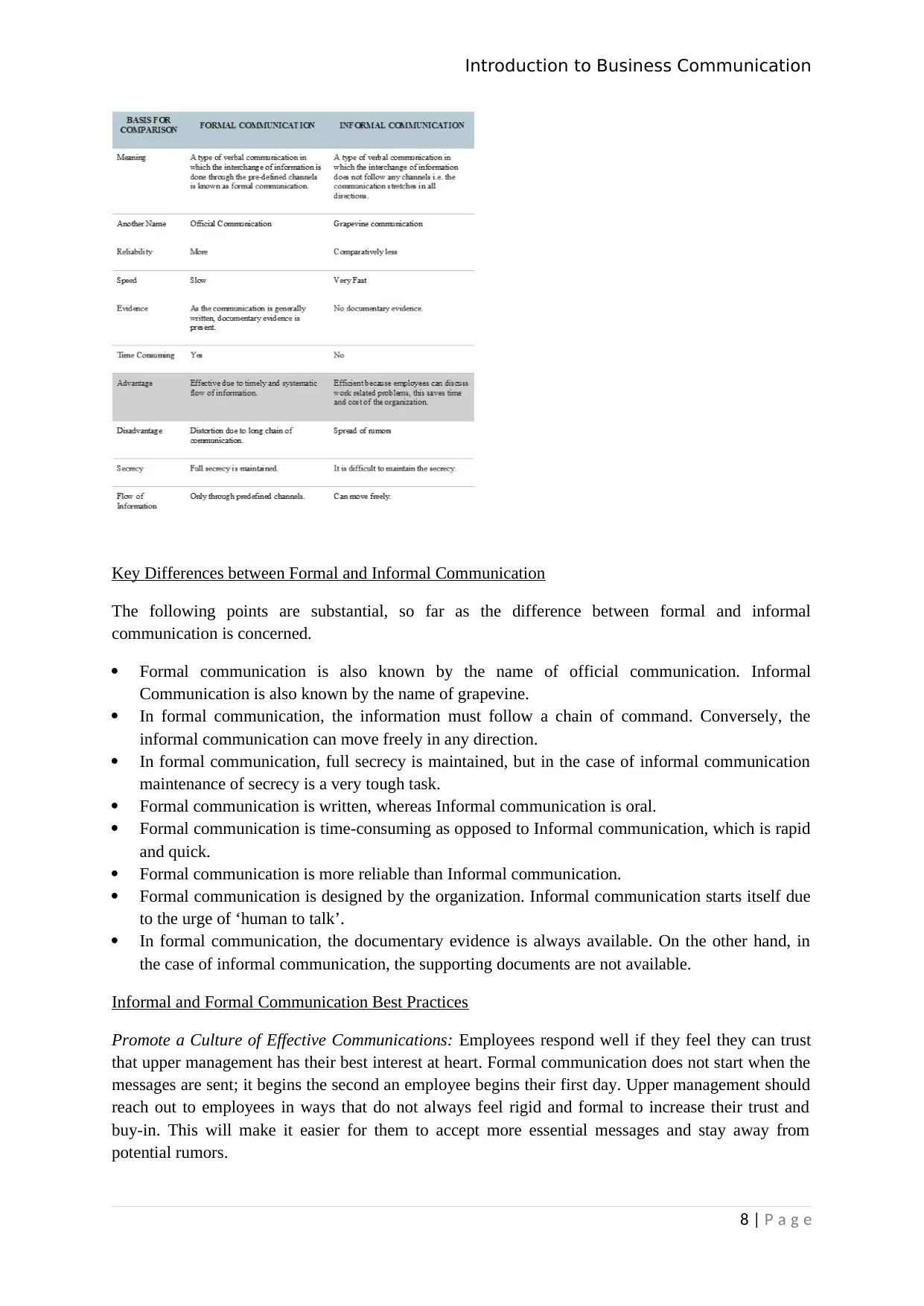
Introduction to Business Communication
Key Differences between Formal and Informal Communication
The following points are substantial, so far as the difference between formal and informal
communication is concerned.
Formal communication is also known by the name of official communication. Informal
Communication is also known by the name of grapevine.
In formal communication, the information must follow a chain of command. Conversely, the
informal communication can move freely in any direction.
In formal communication, full secrecy is maintained, but in the case of informal communication
maintenance of secrecy is a very tough task.
Formal communication is written, whereas Informal communication is oral.
Formal communication is time-consuming as opposed to Informal communication, which is rapid
and quick.
Formal communication is more reliable than Informal communication.
Formal communication is designed by the organization. Informal communication starts itself due
to the urge of ‘human to talk’.
In formal communication, the documentary evidence is always available. On the other hand, in
the case of informal communication, the supporting documents are not available.
Informal and Formal Communication Best Practices
Promote a Culture of Effective Communications: Employees respond well if they feel they can trust
that upper management has their best interest at heart. Formal communication does not start when the
messages are sent; it begins the second an employee begins their first day. Upper management should
reach out to employees in ways that do not always feel rigid and formal to increase their trust and
buy-in. This will make it easier for them to accept more essential messages and stay away from
potential rumors.
8 | P a g e
Key Differences between Formal and Informal Communication
The following points are substantial, so far as the difference between formal and informal
communication is concerned.
Formal communication is also known by the name of official communication. Informal
Communication is also known by the name of grapevine.
In formal communication, the information must follow a chain of command. Conversely, the
informal communication can move freely in any direction.
In formal communication, full secrecy is maintained, but in the case of informal communication
maintenance of secrecy is a very tough task.
Formal communication is written, whereas Informal communication is oral.
Formal communication is time-consuming as opposed to Informal communication, which is rapid
and quick.
Formal communication is more reliable than Informal communication.
Formal communication is designed by the organization. Informal communication starts itself due
to the urge of ‘human to talk’.
In formal communication, the documentary evidence is always available. On the other hand, in
the case of informal communication, the supporting documents are not available.
Informal and Formal Communication Best Practices
Promote a Culture of Effective Communications: Employees respond well if they feel they can trust
that upper management has their best interest at heart. Formal communication does not start when the
messages are sent; it begins the second an employee begins their first day. Upper management should
reach out to employees in ways that do not always feel rigid and formal to increase their trust and
buy-in. This will make it easier for them to accept more essential messages and stay away from
potential rumors.
8 | P a g e
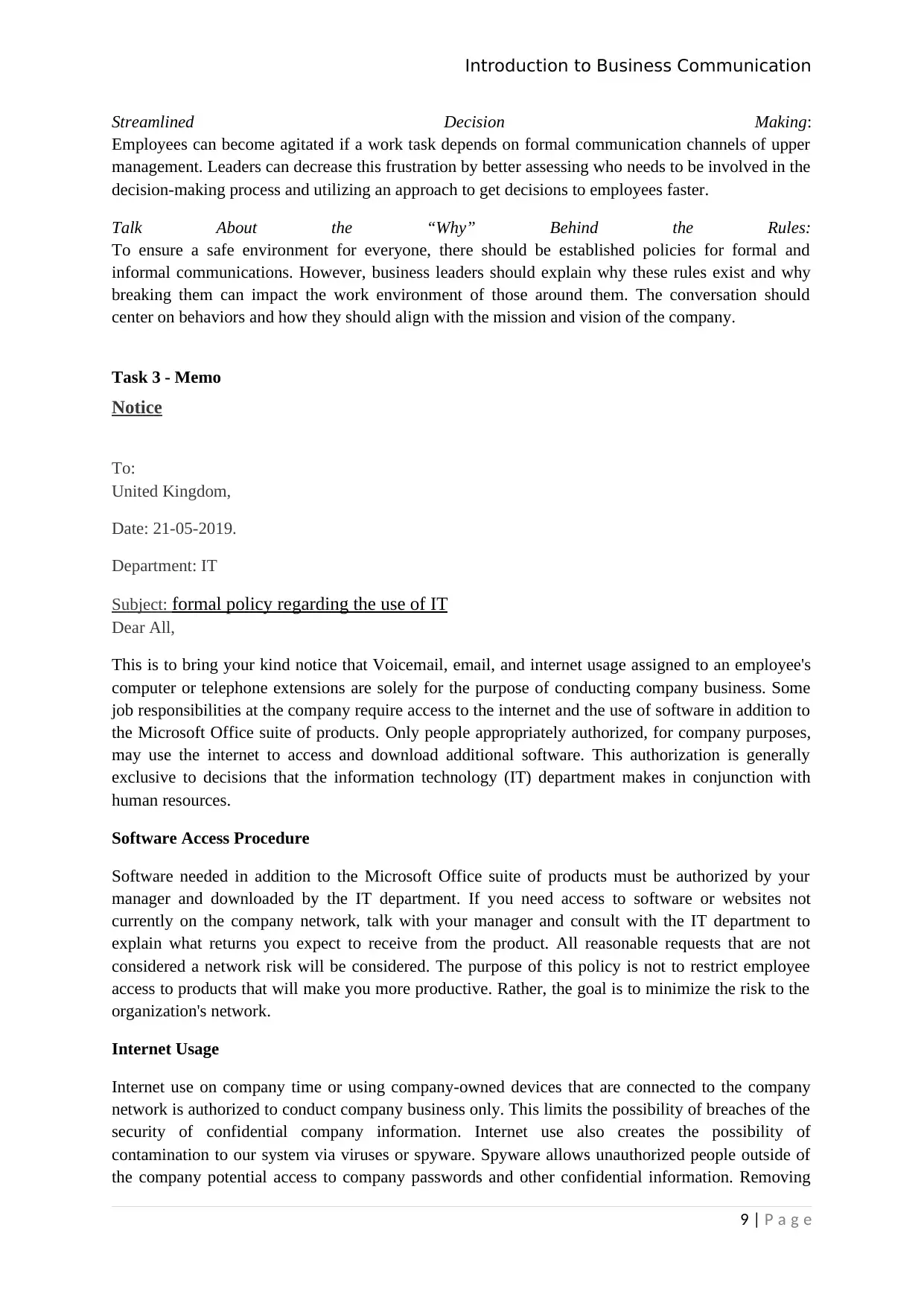
Introduction to Business Communication
Streamlined Decision Making:
Employees can become agitated if a work task depends on formal communication channels of upper
management. Leaders can decrease this frustration by better assessing who needs to be involved in the
decision-making process and utilizing an approach to get decisions to employees faster.
Talk About the “Why” Behind the Rules:
To ensure a safe environment for everyone, there should be established policies for formal and
informal communications. However, business leaders should explain why these rules exist and why
breaking them can impact the work environment of those around them. The conversation should
center on behaviors and how they should align with the mission and vision of the company.
Task 3 - Memo
Notice
To:
United Kingdom,
Date: 21-05-2019.
Department: IT
Subject: formal policy regarding the use of IT
Dear All,
This is to bring your kind notice that Voicemail, email, and internet usage assigned to an employee's
computer or telephone extensions are solely for the purpose of conducting company business. Some
job responsibilities at the company require access to the internet and the use of software in addition to
the Microsoft Office suite of products. Only people appropriately authorized, for company purposes,
may use the internet to access and download additional software. This authorization is generally
exclusive to decisions that the information technology (IT) department makes in conjunction with
human resources.
Software Access Procedure
Software needed in addition to the Microsoft Office suite of products must be authorized by your
manager and downloaded by the IT department. If you need access to software or websites not
currently on the company network, talk with your manager and consult with the IT department to
explain what returns you expect to receive from the product. All reasonable requests that are not
considered a network risk will be considered. The purpose of this policy is not to restrict employee
access to products that will make you more productive. Rather, the goal is to minimize the risk to the
organization's network.
Internet Usage
Internet use on company time or using company-owned devices that are connected to the company
network is authorized to conduct company business only. This limits the possibility of breaches of the
security of confidential company information. Internet use also creates the possibility of
contamination to our system via viruses or spyware. Spyware allows unauthorized people outside of
the company potential access to company passwords and other confidential information. Removing
9 | P a g e
Streamlined Decision Making:
Employees can become agitated if a work task depends on formal communication channels of upper
management. Leaders can decrease this frustration by better assessing who needs to be involved in the
decision-making process and utilizing an approach to get decisions to employees faster.
Talk About the “Why” Behind the Rules:
To ensure a safe environment for everyone, there should be established policies for formal and
informal communications. However, business leaders should explain why these rules exist and why
breaking them can impact the work environment of those around them. The conversation should
center on behaviors and how they should align with the mission and vision of the company.
Task 3 - Memo
Notice
To:
United Kingdom,
Date: 21-05-2019.
Department: IT
Subject: formal policy regarding the use of IT
Dear All,
This is to bring your kind notice that Voicemail, email, and internet usage assigned to an employee's
computer or telephone extensions are solely for the purpose of conducting company business. Some
job responsibilities at the company require access to the internet and the use of software in addition to
the Microsoft Office suite of products. Only people appropriately authorized, for company purposes,
may use the internet to access and download additional software. This authorization is generally
exclusive to decisions that the information technology (IT) department makes in conjunction with
human resources.
Software Access Procedure
Software needed in addition to the Microsoft Office suite of products must be authorized by your
manager and downloaded by the IT department. If you need access to software or websites not
currently on the company network, talk with your manager and consult with the IT department to
explain what returns you expect to receive from the product. All reasonable requests that are not
considered a network risk will be considered. The purpose of this policy is not to restrict employee
access to products that will make you more productive. Rather, the goal is to minimize the risk to the
organization's network.
Internet Usage
Internet use on company time or using company-owned devices that are connected to the company
network is authorized to conduct company business only. This limits the possibility of breaches of the
security of confidential company information. Internet use also creates the possibility of
contamination to our system via viruses or spyware. Spyware allows unauthorized people outside of
the company potential access to company passwords and other confidential information. Removing
9 | P a g e
⊘ This is a preview!⊘
Do you want full access?
Subscribe today to unlock all pages.

Trusted by 1+ million students worldwide
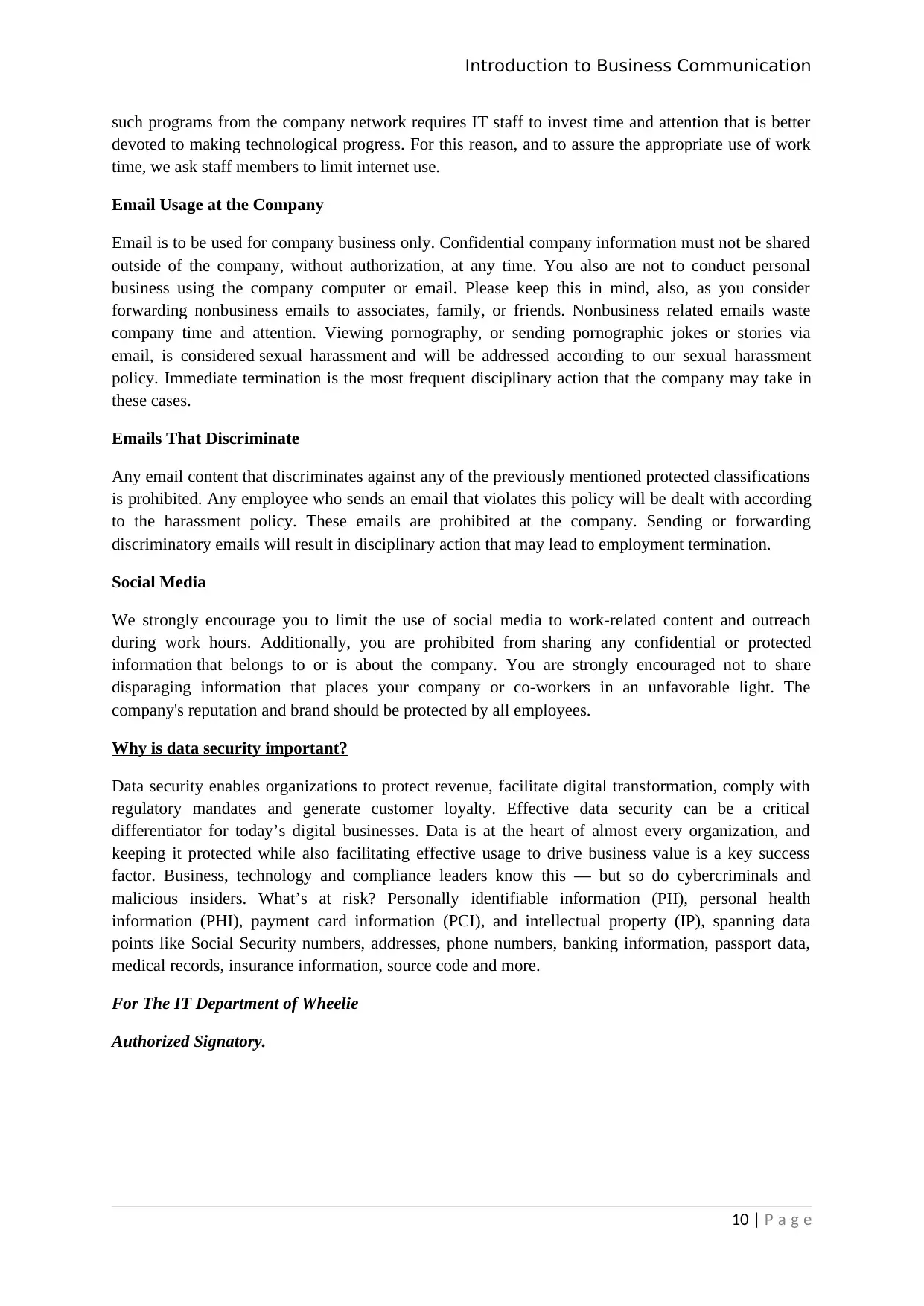
Introduction to Business Communication
such programs from the company network requires IT staff to invest time and attention that is better
devoted to making technological progress. For this reason, and to assure the appropriate use of work
time, we ask staff members to limit internet use.
Email Usage at the Company
Email is to be used for company business only. Confidential company information must not be shared
outside of the company, without authorization, at any time. You also are not to conduct personal
business using the company computer or email. Please keep this in mind, also, as you consider
forwarding nonbusiness emails to associates, family, or friends. Nonbusiness related emails waste
company time and attention. Viewing pornography, or sending pornographic jokes or stories via
email, is considered sexual harassment and will be addressed according to our sexual harassment
policy. Immediate termination is the most frequent disciplinary action that the company may take in
these cases.
Emails That Discriminate
Any email content that discriminates against any of the previously mentioned protected classifications
is prohibited. Any employee who sends an email that violates this policy will be dealt with according
to the harassment policy. These emails are prohibited at the company. Sending or forwarding
discriminatory emails will result in disciplinary action that may lead to employment termination.
Social Media
We strongly encourage you to limit the use of social media to work-related content and outreach
during work hours. Additionally, you are prohibited from sharing any confidential or protected
information that belongs to or is about the company. You are strongly encouraged not to share
disparaging information that places your company or co-workers in an unfavorable light. The
company's reputation and brand should be protected by all employees.
Why is data security important?
Data security enables organizations to protect revenue, facilitate digital transformation, comply with
regulatory mandates and generate customer loyalty. Effective data security can be a critical
differentiator for today’s digital businesses. Data is at the heart of almost every organization, and
keeping it protected while also facilitating effective usage to drive business value is a key success
factor. Business, technology and compliance leaders know this — but so do cybercriminals and
malicious insiders. What’s at risk? Personally identifiable information (PII), personal health
information (PHI), payment card information (PCI), and intellectual property (IP), spanning data
points like Social Security numbers, addresses, phone numbers, banking information, passport data,
medical records, insurance information, source code and more.
For The IT Department of Wheelie
Authorized Signatory.
10 | P a g e
such programs from the company network requires IT staff to invest time and attention that is better
devoted to making technological progress. For this reason, and to assure the appropriate use of work
time, we ask staff members to limit internet use.
Email Usage at the Company
Email is to be used for company business only. Confidential company information must not be shared
outside of the company, without authorization, at any time. You also are not to conduct personal
business using the company computer or email. Please keep this in mind, also, as you consider
forwarding nonbusiness emails to associates, family, or friends. Nonbusiness related emails waste
company time and attention. Viewing pornography, or sending pornographic jokes or stories via
email, is considered sexual harassment and will be addressed according to our sexual harassment
policy. Immediate termination is the most frequent disciplinary action that the company may take in
these cases.
Emails That Discriminate
Any email content that discriminates against any of the previously mentioned protected classifications
is prohibited. Any employee who sends an email that violates this policy will be dealt with according
to the harassment policy. These emails are prohibited at the company. Sending or forwarding
discriminatory emails will result in disciplinary action that may lead to employment termination.
Social Media
We strongly encourage you to limit the use of social media to work-related content and outreach
during work hours. Additionally, you are prohibited from sharing any confidential or protected
information that belongs to or is about the company. You are strongly encouraged not to share
disparaging information that places your company or co-workers in an unfavorable light. The
company's reputation and brand should be protected by all employees.
Why is data security important?
Data security enables organizations to protect revenue, facilitate digital transformation, comply with
regulatory mandates and generate customer loyalty. Effective data security can be a critical
differentiator for today’s digital businesses. Data is at the heart of almost every organization, and
keeping it protected while also facilitating effective usage to drive business value is a key success
factor. Business, technology and compliance leaders know this — but so do cybercriminals and
malicious insiders. What’s at risk? Personally identifiable information (PII), personal health
information (PHI), payment card information (PCI), and intellectual property (IP), spanning data
points like Social Security numbers, addresses, phone numbers, banking information, passport data,
medical records, insurance information, source code and more.
For The IT Department of Wheelie
Authorized Signatory.
10 | P a g e
Paraphrase This Document
Need a fresh take? Get an instant paraphrase of this document with our AI Paraphraser
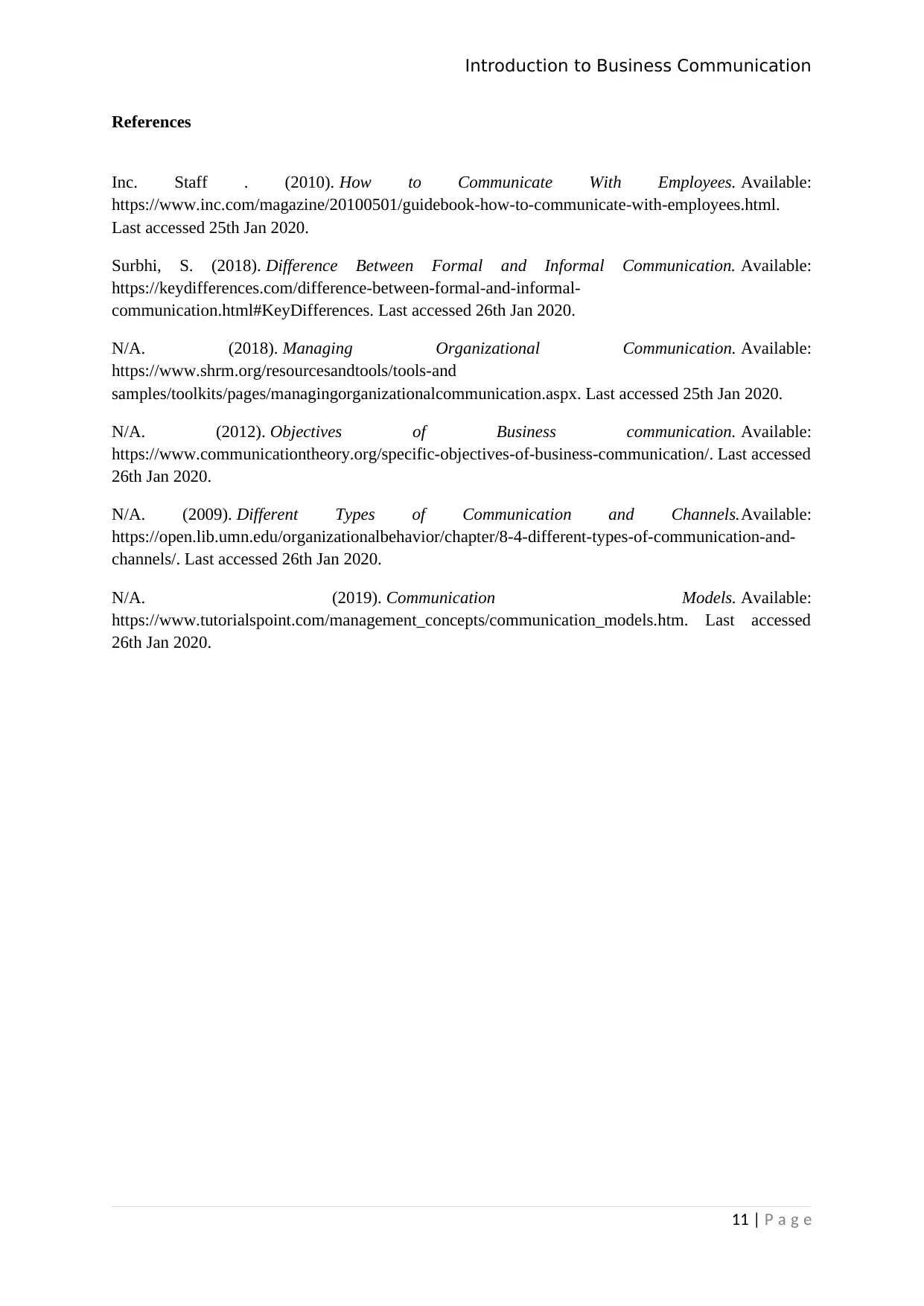
Introduction to Business Communication
References
Inc. Staff . (2010). How to Communicate With Employees. Available:
https://www.inc.com/magazine/20100501/guidebook-how-to-communicate-with-employees.html.
Last accessed 25th Jan 2020.
Surbhi, S. (2018). Difference Between Formal and Informal Communication. Available:
https://keydifferences.com/difference-between-formal-and-informal-
communication.html#KeyDifferences. Last accessed 26th Jan 2020.
N/A. (2018). Managing Organizational Communication. Available:
https://www.shrm.org/resourcesandtools/tools-and
samples/toolkits/pages/managingorganizationalcommunication.aspx. Last accessed 25th Jan 2020.
N/A. (2012). Objectives of Business communication. Available:
https://www.communicationtheory.org/specific-objectives-of-business-communication/. Last accessed
26th Jan 2020.
N/A. (2009). Different Types of Communication and Channels.Available:
https://open.lib.umn.edu/organizationalbehavior/chapter/8-4-different-types-of-communication-and-
channels/. Last accessed 26th Jan 2020.
N/A. (2019). Communication Models. Available:
https://www.tutorialspoint.com/management_concepts/communication_models.htm. Last accessed
26th Jan 2020.
11 | P a g e
References
Inc. Staff . (2010). How to Communicate With Employees. Available:
https://www.inc.com/magazine/20100501/guidebook-how-to-communicate-with-employees.html.
Last accessed 25th Jan 2020.
Surbhi, S. (2018). Difference Between Formal and Informal Communication. Available:
https://keydifferences.com/difference-between-formal-and-informal-
communication.html#KeyDifferences. Last accessed 26th Jan 2020.
N/A. (2018). Managing Organizational Communication. Available:
https://www.shrm.org/resourcesandtools/tools-and
samples/toolkits/pages/managingorganizationalcommunication.aspx. Last accessed 25th Jan 2020.
N/A. (2012). Objectives of Business communication. Available:
https://www.communicationtheory.org/specific-objectives-of-business-communication/. Last accessed
26th Jan 2020.
N/A. (2009). Different Types of Communication and Channels.Available:
https://open.lib.umn.edu/organizationalbehavior/chapter/8-4-different-types-of-communication-and-
channels/. Last accessed 26th Jan 2020.
N/A. (2019). Communication Models. Available:
https://www.tutorialspoint.com/management_concepts/communication_models.htm. Last accessed
26th Jan 2020.
11 | P a g e
1 out of 11
Related Documents
Your All-in-One AI-Powered Toolkit for Academic Success.
+13062052269
info@desklib.com
Available 24*7 on WhatsApp / Email
![[object Object]](/_next/static/media/star-bottom.7253800d.svg)
Unlock your academic potential
Copyright © 2020–2025 A2Z Services. All Rights Reserved. Developed and managed by ZUCOL.





